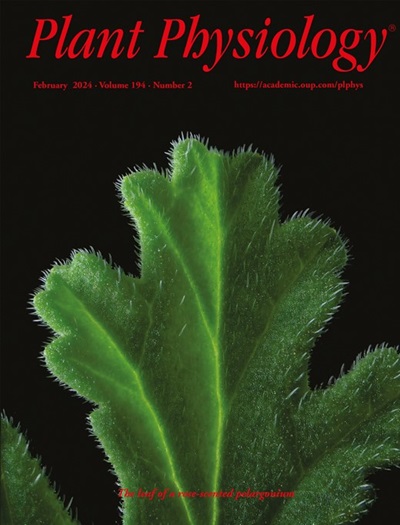High-light-inducible proteins control associations between chlorophyll synthase and the Photosystem II biogenesis factor Ycf39
IF 6.5
1区 生物学
Q1 PLANT SCIENCES
引用次数: 0
Abstract
The biogenesis of Photosystem II is a complicated process requiring numerous auxiliary factors to assist in all steps of its assembly. The cyanobacterial protein Ycf39 forms a stress-induced complex with two small chlorophyll-binding, High-light-inducible proteins C and D (HliC and HliD), and has been reported to participate in the insertion of chlorophyll molecules into the central D1 subunit of Photosystem II. However, how this process is organized remains unknown. Here, we show that Ycf39 and both HliC and HliD can form distinct complexes with chlorophyll synthase (ChlG) in the model cyanobacterium Synechocystis sp. PCC 6803. We isolated and characterized ChlG complexes from various strains grown under different conditions and provide a mechanistic view of the docking of Ycf39 to ChlG via HliD and the structural role of HliC. In the absence of stress, chlorophyll is produced by the ChlG-HliD2-ChlG complex, which is stabilized by chlorophyll and zeaxanthin molecules bound to the HliD homodimer. The switch to high light leads to stress pressure and greatly elevated synthesis of HliC, resulting in the replacement of HliD homodimers with HliC-HliD heterodimers. Unlike HliD, HliC cannot interact directly with ChlG or Ycf39. Therefore, the original ChlG-HliD2-ChlG complex is converted into a ChlG-HliD-HliC hetero-trimer that presumably binds transiently to Ycf39 and the nascent D1 polypeptide. We speculate that this molecular machinery promotes the delivery of chlorophyll to D1 upon high-light-induced chlorophyll deficiency. The HliD homodimers formed under standard, non-stress growth conditions and attached to ChlG could serve as an emergency chlorophyll reserve.高光诱导蛋白控制叶绿素合酶和光系统II生物发生因子Ycf39之间的关联
光系统II的生物发生是一个复杂的过程,需要许多辅助因素来协助其组装的所有步骤。蓝藻蛋白Ycf39与两个小的叶绿素结合,高光诱导蛋白C和D (HliC和HliD)形成应激诱导复合物,据报道参与叶绿素分子插入光系统II的中心D1亚基。然而,这个过程是如何组织的仍然未知。本研究表明,Ycf39、HliC和HliD均可与模式蓝细菌Synechocystis sp. PCC 6803中的叶绿素合成酶(ChlG)形成不同的复合物。我们从不同条件下生长的不同菌株中分离并表征了ChlG复合物,并对Ycf39通过HliD与ChlG对接的机制以及HliC的结构作用进行了研究。在没有胁迫的情况下,叶绿素由ChlG-HliD2-ChlG复合物产生,该复合物由叶绿素和与HliD同二聚体结合的玉米黄质分子稳定。切换到高光导致应力压力和HliC的合成大大增加,导致HliD同型二聚体被HliC-HliD异源二聚体取代。与HliD不同,HliC不能直接与ChlG或Ycf39相互作用。因此,最初的ChlG-HliD2-ChlG复合物被转化为chlg - hlid2 - hlic异质三聚体,可能与Ycf39和新生的D1多肽短暂结合。我们推测,这种分子机制促进了在强光诱导的叶绿素缺乏时叶绿素向D1的传递。在标准、非胁迫生长条件下形成的HliD同型二聚体附着在ChlG上,可作为叶绿素应急储备。
本文章由计算机程序翻译,如有差异,请以英文原文为准。
求助全文
约1分钟内获得全文
求助全文
来源期刊

Plant Physiology
生物-植物科学
CiteScore
12.20
自引率
5.40%
发文量
535
审稿时长
2.3 months
期刊介绍:
Plant Physiology® is a distinguished and highly respected journal with a rich history dating back to its establishment in 1926. It stands as a leading international publication in the field of plant biology, covering a comprehensive range of topics from the molecular and structural aspects of plant life to systems biology and ecophysiology. Recognized as the most highly cited journal in plant sciences, Plant Physiology® is a testament to its commitment to excellence and the dissemination of groundbreaking research.
As the official publication of the American Society of Plant Biologists, Plant Physiology® upholds rigorous peer-review standards, ensuring that the scientific community receives the highest quality research. The journal releases 12 issues annually, providing a steady stream of new findings and insights to its readership.
 求助内容:
求助内容: 应助结果提醒方式:
应助结果提醒方式:


